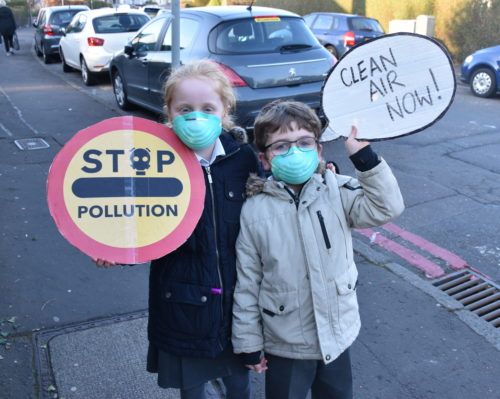
Campaigners, parents & pollution experts highlight benefits LEZ will bring
As Glasgow’s Low Emission Zone is due to start in a month’s time (1 June), campaigners and air pollution experts are highlighting how the city’s residents can look forward to breathing less toxic air.
The Low Emission Zone will restrict the most polluting vehicles, with drivers receiving a fine – similar to a parking or speeding fine – if a non-compliant vehicle enters the zone.
Glasgow has been slowly restricting more and more of the most polluting buses over the last few years, and this has already brought some big improvements to air quality in the city. Restrictions on cars and other vehicle types will begin on 1 June, which will bring the pollution levels down further.
Air pollution cuts short over 2,500 lives in Scotland each year and puts the population at risk of serious health conditions, like asthma, heart attacks, and strokes. It’s especially harmful to children, the elderly, and people living in poverty or made vulnerable from other health conditions.
Glasgow has higher rates of hospitalisation than the rest of the country for both children and adults with asthma, and people with COPD. Meanwhile it has the lowest level of car ownership, with only 31% of lower-income households having a car.
Friends of the Earth Scotland’s Transport Campaigner Gavin Thomson said:
“Glasgow has been breathing toxic, illegal fumes for years and that’s finally coming to an end. From June 1st, anyone in Glasgow’s city centre can breathe easier due to the Low Emission Zone which restricts the most polluting vehicles.
“We know that LEZs work because they’re in place across Europe, and Glasgow’s zone has already had a positive impact. We know the LEZ has a lot of support, as people are worried about the impact of air pollution on their health. And we also know that the zone will help the city address climate change, as we move to more sustainable modes of travel.
“With the Avenues project, which will introduce bike lanes, benches and street trees across the city, the changes to George Square and now the Low Emission Zone, Glasgow is changing. The city is becoming greener and healthier, and leading the way for Scotland’s cities.”
Gareth Brown, Chair of Healthy Air Scotland and Policy and Public Affairs Officer, Asthma + Lung UK Scotland said:
“Air pollution can cause new lung conditions like lung cancer and worsening existing ones. With 1 in 5 Scots developing a lung condition like asthma and chronic obstructive pulmonary disease – COPD – in their lifetime, for them, it can trigger life-threatening asthma attacks and exacerbations.
“Communities want bold action on toxic air and for governments to help them protect their health and their families. No one wants to see their loved one fight for breath just because the air they breathe is toxic.
“We need to make tackling air pollution a national priority. Low Emission Zones are just the start. We all need to think about how we live, how we work and how we travel. We need to incentivise the behavioural change needed to create a world of clean air and healthy lungs.”
Leanne McGuire, chairperson of Glasgow City Parents Group, said:
“As parents, we are always concerned about any risks to our children’s health, and that includes air pollution.
“The introduction of the Low Emission Zones in Glasgow means that whether our children are walking or cycling to school, or enjoying a family day out in the city, we can feel more confident in the reduced levels of pollution they are exposed to.
“There are a number of schools in the city centre adjacent to a busy road. The LEZ will reduce the health risks to those schools, improving air quality, and creating a positive impact on pupils’ health.”
Dr Ruaraidh Dobson, Senior Research Analyst and air quality lead at Trilateral Research, said:
“Glasgow has high levels of traffic pollution, particularly nitrogen dioxide. Low emission zones play a key role in changing that – they work to get cars off the road. That helps protect children from developing asthma and keep our communities healthy.”
